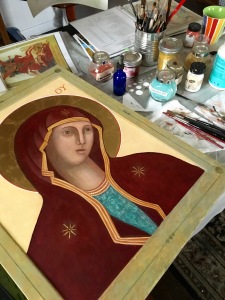Renewal in Liturgical Art- Encompassing Differing Worldviews in One Faith
A world view is a pattern of ideas and beliefs. Everyone seeks answers to the questions of “why are we here? What is the meaning and purpose of life? Is there a difference between right and wrong? Is there a God? Do our actions have consequences? Is there a connection between this visible world and an invisible one? Our world view helps us to make sense of our being, our God, our purpose in this world. The Christian worldview has a narrative of all history, as told in the Old and New Testaments.
What is our world view as Christian artists and Iconographers? For each of us this may be defined differently with fine nuances, depending on our denominational affiliations. The Eastern and Western Churches evolved from the same beginning, yet have grown to have differences in art, liturgy, theology, etc.
So, finding common ground, much as our forefathers and mothers all experienced in the early church, is a worthy goal for Sacred Art makers of today.
Christian Renewal
The renewal of the mind involves a transformation of the way a person thinks and lives, which can be achieved through the power of the Holy Spirit as we reflect on God’s word. By being transformed in this way, believers can discern what is good, acceptable, and perfect according to God’s standards.
“Don’t copy the behavior and customs of this world, but let God transform you into a new person by changing the way you think>”. Romans 12:2
I’ve researched some very good books on related subjects and have gathered some thoughts for you. I include at the end of this article titles and authors of each book mentioned here.
Liturgical Art Renewal
Our goal, as iconographers, is to help others to see the sacred more deeply proclaim the Gospel more faithfully and pray together more honestly, using our eyes, our hearts, and our minds. And our hands.
An icon mediates or contains the Holy Presence
“The artist’s task is not merely to record but also to present the result of the encounter as it is shaped by that disciplined imagination…One can be in a kind of dialogue with the thing being observed or between the thing imagined and that which is produced.
Christian worship is aided immeasurably by our sense of sight. In worship we see each other and gain a glimpse of what it means to be the body of Christ.” Beauty, Spirit, Matter, Icons in the Modern World., Aidan Hart
“The spirit which knows God naturally comprehends divine beauty and seeks to delight in it alone. . .To contemplate divine beauty, to delight in it and partake in it is a requirement of the Spirit and is its life and heavenly life.” Theophan the Recluse (1880)
The icon is a radical way of seeing and therefore suggests a radical way of acting. When we look at an icon we are seeing as a saint sees.
An icon is not merely a painting of a religious subject but a crystallization of a whole culture, a culture which worships God and therefore venerates the material world that He created as a gift.’
Art is something essential to the shaping of faith and religious experience.
Sacred art is always abstract, in that word’s literal sense. In that it draws out the essence of its subject. It uses stylistic abstraction to suggest these invisible realities….Sacred art typically reveals the union of the inner with the outer, the invisible with the visible. Iconographic depictions of great suffering, such as the Crucifixion, keep this suffering united to love and hope. They show that the suffering is genuine, but they also show that this suffering is on the road to the Resurrection. An icon always joins opposites.
An icon brings the good news into the world by showing the face of Jesus Christ: God became man. Moreover, through Christ, the icon reveals to us the true image of humanity transfigured and deified; it is the image of the kingdom of heaven, the kingdom that is to come and that will restore the harmony now marred by sin…if an icon depicts a saint, its real purpose is to bring us face to face with someone in whom God’s goodness shines forth.” Irina Yazykova
“Eyes of fire perceive each thing as the outer sign of an inner fact, or the local sign of a distant power. For such eyes nothing is lonely matter, all things are caught up in a mysterious, ultimately divine whole that challenges understanding over a lifetime. Eyes of flesh focus on the thing itself, eyes of fire on facts but still more intently on their participation in a larger meaning by which they are raised.” An Art of Our Own, the Spiritual in Twentieth Century Art, Roger Lipsey
Books and Related Links
- The Substance of Things Seen, Art, Faith, and the Christian Community by Robin M. Jensen
- An Art of Our Own, the Spiritual in Twentieth Century Art, Roger Lipsey
- Beauty, Spirit, Matter, Icons in the Modern World, Aidan Hart
- Eyes of Fire, Christine Hales
An Excellent Series of Talks at the Cathedral of All Saints Divine, Albany NY, by Brynna Carpenter-Nardone :
- “Art Seeking Understanding, Part I” https://www.cathedralofallsaints.org/cathedral-arts-blog/art-seeking-understanding-1
- Art Seeking Understanding, Part II. https://www.cathedralofallsaints.org/cathedral-arts-blog
Lots to think and pray about! That’s all for this month,
May God continue to renew your minds in Him, and bless the work of your hands,
Christine Hales















